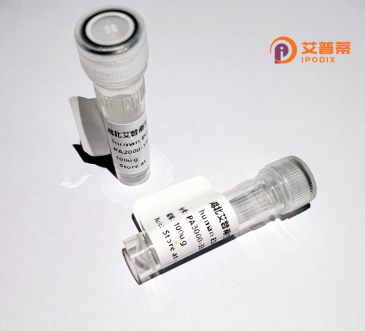
| 纯度 | >90%SDS-PAGE. |
| 种属 | Human |
| 靶点 | ATPBD1B |
| Uniprot No | Q9H9Y4 |
| 内毒素 | < 0.01EU/μg |
| 表达宿主 | E.coli |
| 表达区间 | 1-310aa |
| 氨基酸序列 | MAGAAPTTAF GQAVIGPPGS GKTTYCLGMS EFLRALGRRV AVVNLDPANE GLPYECAVDV GELVGLGDVM DALRLGPNGG LLYCMEYLEA NLDWLRAKLD PLRGHYFLFD CPGQVELCTH HGALRSIFSQ MAQWDLRLTA VHLVDSHYCT DPAKFISVLC TSLATMLHVE LPHINLLSKM DLIEHYGKLA FNLDYYTEVL DLSYLLDHLA SDPFFRHYRQ LNEKLVQLIE DYSLVSFIPL NIQDKESIQR VLQAVDKANG YCFRAQEQRS LEAMMSAAMG ADFHFSSTLG IQEKYLAPSN QSVEQEAMQL |
| 分子量 | 60.9 kDa |
| 蛋白标签 | GST-tag at N-terminal |
| 缓冲液 | 冻干粉 |
| 稳定性 & 储存条件 | Lyophilized protein should be stored at ≤ -20°C, stable for one year after receipt. Reconstituted protein solution can be stored at 2-8°C for 2-7 days. Aliquots of reconstituted samples are stable at ≤ -20°C for 3 months. |
| 复溶 | Always centrifuge tubes before opening.Do not mix by vortex or pipetting. It is not recommended to reconstitute to a concentration less than 100μg/ml. Dissolve the lyophilized protein in distilled water. Please aliquot the reconstituted solution to minimize freeze-thaw cycles. |
以下是关于重组人V-ATP酶B1亚基(假设为ATP6V1B1/ATPBD1B)的3篇参考文献的简要列举(注:由于该蛋白名称可能存在拼写差异,建议结合具体研究领域核实):
---
1. **文献名称**: "Structure and Function of Vacuolar ATPase: Proton Pumping and Beyond"
**作者**: Forgac, M.
**摘要**: 综述V-ATP酶的结构与功能,阐述其B1亚基(ATP6V1B1)在质子转运中的核心作用,及与肾小管酸中毒、肿瘤转移等疾病的关联。
2. **文献名称**: "Expression and Functional Characterization of Recombinant Human V-ATPase B1 Subunit in Yeast"
**作者**: Su, Y. et al.
**摘要**: 报道利用酵母系统表达重组人V-ATP酶B1亚基,验证其参与溶酶体酸化及维持细胞pH稳态的功能,为疾病机制研究提供工具。
3. **文献名称**: "Mutation Analysis of ATP6V1B1 in Patients with Renal Tubular Acidosis"
**作者**: Karet, F.E. et al.
**摘要**: 发现ATP6V1B1基因突变导致常染色体隐性遗传性远端肾小管酸中毒,为重组蛋白研究提供病理学依据。
---
**注意**:若目标蛋白为冷门或名称有误,建议结合基因数据库(如UniProt)确认标准命名后进一步检索。
Recombinant human V-ATPase B1/ATP6V1B (ATP6V1B1) protein, also known as ATP-binding domain-containing protein 1B, is a subunit of vacuolar-type H+-ATPase (V-ATPase), a multi-subunit proton pump critical for cellular pH regulation. V-ATPases acidify intracellular compartments (e.g., lysosomes, endosomes) and participate in extracellular proton secretion in specialized cells like renal intercalated cells. The ATP6V1B1 subunit localizes to the cytoplasmic V1 domain, contributing to ATP hydrolysis and energy transduction during proton transport.
This protein is expressed in multiple tissues, with high levels in kidney, inner ear, and immune cells. Mutations in ATP6V1B1 are linked to autosomal recessive distal renal tubular acidosis (dRTA), characterized by impaired urinary acidification, metabolic acidosis, and sensorineural hearing loss. Recombinant ATP6V1B1 is typically produced in mammalian or microbial expression systems, preserving functional ATPase activity and structural integrity. Its applications include biochemical studies of V-ATPase assembly/function, screening ATPase inhibitors, and generating antibodies for disease diagnostics. Current research focuses on its role in acid-base homeostasis, osteoclast-mediated bone resorption, and tumor microenvironment acidification, highlighting therapeutic potential in metabolic disorders, cancer, and immune modulation.
×